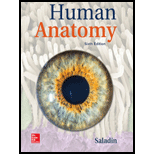
Concept explainers
To determine:
The different components that constitute a lymphatic system.
Introduction:
The major function of the lymphatic system is to maintain the balance between body fluids. It also provides immunity by generating different types of immune cells. It is not possible for the circulatory system and immune system to work without the lymphatic system.
Explanation of Solution
The lymphatic system comprises of the following components:
- Lymph:
- Lymphatic vessels:
- Lymphatic tissues:
- Lymphatic organs:
A fluid similar to blood plasma that is usually clear and colorless and is low in protein content. This fluid is taken up by the lymphatic vessels. The composition of lymph varies from time to time and from place to place. For example: after a meal, the lymph turns to milky in appearance due to the presence of high lipid content. The different substances that are present in the lymph are macrophages, hormones, bacteria, viruses and traveling cancer cells.
These are similar to that of blood vessels. These vessels reach every part of the body except cartilage, bone, bone marrow and cornea. These vessels close at one end
The aggregation of the cells, lymphocytes forms the lymphatic tissue. The simplest type of lymphatic tissue is that in which lymphocytes are not densely clustered rather, they are scattered. These simple types of lymphatic tissues are referred to as diffuse lymphatic tissue.
These are also known as lymphoid organs. Redbone marrow, thymus, lymph nodes, tonsils and spleen all come under lymphatic organs. Out of these, red bone marrow and thymus come under primary lymphatic tissue, and rest all are categorized under the secondary lymphatic organs.
The lymphatic organs are vital for our body as it helps in producing different types of response against any bacteria or virus that invades in the human body.
Want to see more full solutions like this?
Chapter 22 Solutions
Human Anatomy
- Skryf n kortkuns van die Egyptians pyramids vertel ñ story. Maximum 500 woordearrow_forward1.)What cross will result in half homozygous dominant offspring and half heterozygous offspring? 2.) What cross will result in all heterozygous offspring?arrow_forward1.Steroids like testosterone and estrogen are nonpolar and large (~18 carbons). Steroids diffuse through membranes without transporters. Compare and contrast the remaining substances and circle the three substances that can diffuse through a membrane the fastest, without a transporter. Put a square around the other substance that can also diffuse through a membrane (1000x slower but also without a transporter). Molecule Steroid H+ CO₂ Glucose (C6H12O6) H₂O Na+ N₂ Size (Small/Big) Big Nonpolar/Polar/ Nonpolar lonizedarrow_forward
- what are the answer from the bookarrow_forwardwhat is lung cancer why plants removes liquid water intead water vapoursarrow_forward*Example 2: Tracing the path of an autosomal dominant trait Trait: Neurofibromatosis Forms of the trait: The dominant form is neurofibromatosis, caused by the production of an abnormal form of the protein neurofibromin. Affected individuals show spots of abnormal skin pigmentation and non-cancerous tumors that can interfere with the nervous system and cause blindness. Some tumors can convert to a cancerous form. i The recessive form is a normal protein - in other words, no neurofibromatosis.moovi A typical pedigree for a family that carries neurofibromatosis is shown below. Note that carriers are not indicated with half-colored shapes in this chart. Use the letter "N" to indicate the dominant neurofibromatosis allele, and the letter "n" for the normal allele. Nn nn nn 2 nn Nn A 3 N-arrow_forward
- I want to be a super nutrition guy what u guys like recommend mearrow_forwardPlease finish the chart at the bottom. Some of the answers have been filled in.arrow_forward9. Aerobic respiration of one lipid molecule. The lipid is composed of one glycerol molecule connected to two fatty acid tails. One fatty acid is 12 carbons long and the other fatty acid is 18 carbons long in the figure below. Use the information below to determine how much ATP will be produced from the glycerol part of the lipid. Then, in part B, determine how much ATP is produced from the 2 fatty acids of the lipid. Finally put the NADH and ATP yields together from the glycerol and fatty acids (part A and B) to determine your total number of ATP produced per lipid. Assume no other carbon source is available. 18 carbons fatty acids 12 carbons 9 glycerol A. Glycerol is broken down to glyceraldehyde 3-phosphate, a glycolysis intermediate via the following pathway shown in the figure below. Notice this process costs one ATP but generates one FADH2. Continue generating ATP with glyceraldehyde-3-phosphate using the standard pathway and aerobic respiration. glycerol glycerol-3- phosphate…arrow_forward
 Medical Terminology for Health Professions, Spira...Health & NutritionISBN:9781305634350Author:Ann Ehrlich, Carol L. Schroeder, Laura Ehrlich, Katrina A. SchroederPublisher:Cengage Learning
Medical Terminology for Health Professions, Spira...Health & NutritionISBN:9781305634350Author:Ann Ehrlich, Carol L. Schroeder, Laura Ehrlich, Katrina A. SchroederPublisher:Cengage Learning





